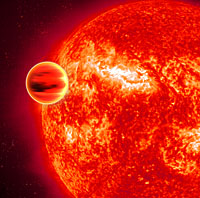A must-read for designers. Awesome 5-color screen print tutorial that saved my ass today.
read more | digg story
Tuesday, February 12, 2008
Screen Print Like A Bad Ass
Wednesday, December 19, 2007
Tuesday, November 20, 2007
Stem cell breakthrough uses no embryos - Yahoo! News
Stem cell breakthrough uses no embryos - Yahoo! News
By MALCOLM RITTER, AP Science Writer 13 minutes ago
NEW YORK - Scientists have made ordinary human skin cells take on the chameleon-like powers of embryonic stem cells, a startling breakthrough that might someday deliver the medical payoffs of embryo cloning without the controversy.
Laboratory teams on two continents report success in a pair of landmark papers released Tuesday. It's a neck-and-neck finish to a race that made headlines five months ago, when scientists announced that the feat had been accomplished in mice.
The "direct reprogramming" technique avoids the swarm of ethical, political and practical obstacles that have stymied attempts to produce human stem cells by cloning embryos.
Scientists familiar with the work said scientific questions remain and that it's still important to pursue the cloning strategy, but that the new work is a major coup.
"This work represents a tremendous scientific milestone — the biological equivalent of the Wright Brothers' first airplane," said Dr. Robert Lanza, chief science officer of Advanced Cell Technology, which has been trying to extract stem cells from cloned human embryos.
"It's a bit like learning how to turn lead into gold," said Lanza, while cautioning that the work is far from providing medical payoffs.
"It's a huge deal," agreed Rudolf Jaenisch, a prominent stem cell scientist at the Whitehead Institute in Cambridge, Mass. "You have the proof of principle that you can do it."
The White House lauded the papers, saying such research is what President Bush was advocating when he twice vetoed legislation to pave the way for taxpayer-funded embryo research.
There is a catch with the new technique. At this point, it requires disrupting the DNA of the skin cells, which creates the potential for developing cancer. So it would be unacceptable for the most touted use of embryonic cells: creating transplant tissue that in theory could be used to treat diseases like diabetes, Parkinson's, and spinal cord injury.
But the DNA disruption is just a byproduct of the technique, and experts said they believe it can be avoided.
The new work is being published online by two journals, Cell and Science. The Cell paper is from a team led by Dr. Shinya Yamanaka of Kyoto University; the Science paper is from a team led by Junying Yu, working in the lab of in stem-cell pioneer James Thomson of the University of Wisconsin-Madison.
Both reported creating cells that behaved like stem cells in a series of lab tests.
Thomson, 48, made headlines in 1998 when he announced that his team had isolated human embryonic stem cells.
Yamanaka gained scientific notice in 2006 by reporting that direct reprogramming in mice had produced cells resembling embryonic stem cells, although with significant differences. In June, his group and two others announced they'd created mouse cells that were virtually indistinguishable from stem cells.
For the new work, the two men chose different cell types from a tissue supplier. Yamanaka reprogrammed skin cells from the face of an unidentified 36-year-old woman, and Thomson's team worked with foreskin cells from a newborn. Thomson, who was working his way from embryonic to fetal to adult cells, said he's still analyzing his results with adult cells.
Both labs did basically the same thing. Each used viruses to ferry four genes into the skin cells. These particular genes were known to turn other genes on and off, but just how they produced cells that mimic embryonic stem cells is a mystery.
"People didn't know it would be this easy," Thomson said. "Thousands of labs in the United States can do this, basically tomorrow."
The Wisconsin Alumni Research Foundation, which holds three patents for Thomson's work, is applying for patents involving his new research, a spokeswoman said. Two of the four genes he used were different from Yamanaka's recipe.
Scientists prize embryonic stem cells because they can turn into virtually any kind of cell in the body. The cloning approach — which has worked so far only in mice and monkeys — should be able to produce stem cells that genetically match the person who donates body cells for cloning.
That means tissue made from the cells should be transplantable into that person without fear of rejection. Scientists emphasize that any such payoff would be well in the future, and that the more immediate medical benefits would come from basic research in the lab.
In fact, many scientists say the cloning technique has proven too expensive and cumbersome in its current form to produce stem cells routinely for transplants.
The new work shows that the direct reprogramming technique can also produce versatile cells that are genetically matched to a person. But it avoids several problems that have bedeviled the cloning approach.
For one thing, it doesn't require a supply of unfertilized human eggs, which are hard to obtain for research and subjects the women donating them to a surgical procedure. Using eggs also raises the ethical questions of whether women should be paid for them.
In cloning, those eggs are used to make embryos from which stem cells are harvested. But that destroys the embryos, which has led to political opposition from President Bush, the Roman Catholic church and others.
Those were "show-stopping ethical problems," said Laurie Zoloth, director of Northwestern University's Center for Bioethics, Science and Society.
The new work, she said, "redefines the ethical terrain."
Richard Doerflinger of the U.S. Conference of Catholic Bishops called the new work "a very significant breakthrough in finding morally unproblematic alternatives to cloning. ... I think this is something that would be readily acceptable to Catholics."
White House spokesman Tony Fratto said the new method does not cross what Bush considers an "ethical line." And Republican Sen. Tom Coburn of Oklahoma, a staunch opponent of publicly funded embryonic stem cell research, said it should nullify the debate.
Another advantage of direct reprogramming is that it would qualify for federal research funding, unlike projects that seek to extract stem cells from human embryos, noted Doug Melton, co-director of the Harvard Stem Cell Institute.
Still, scientific questions remain about the cells produced by direct reprogramming, called "iPS" cells. One is how the cells compare to embryonic stem cells in their behavior and potential. Yamanaka said his work detected differences in gene activity.
If they're different, iPS cells might prove better for some scientific uses and cloned stem cells preferable for other uses. Scientists want to study the roots of genetic disease and screen potential drug treatments in their laboratories, for example.
Scottish researcher Ian Wilmut, famous for his role in cloning Dolly the sheep a decade ago, told London's Daily Telegraph that he is giving up the cloning approach to produce stem cells and plans to pursue direct reprogramming instead.
Other scientists said it's too early for the field to follow Wilmut's lead. Cloning embryos to produce stem cells remains too valuable as a research tool, Jaenisch said.
Dr. George Daley of the Harvard institute, who said his own lab has also achieved direct reprogramming of human cells, said it's not clear how long it will take to get around the cancer risk problem. Nor is it clear just how direct reprogramming works, or whether that approach mimics what happens in cloning, he noted.
So the cloning approach still has much to offer, he said.
Daley, who's president of the International Society for Stem Cell Research, said his lab is pursuing both strategies.
"We'll see, ultimately, which one works and which one is more practical."
___
Associated Press writer Laurie Kellman contributed to this report from Washington.
___
On the Net:
Journal Cell: http://www.cell.com
Journal Science: http://www.sciencemag.org
Thursday, September 27, 2007
Monday, September 24, 2007
Sunday, September 23, 2007
Friday, September 21, 2007
Thursday, September 20, 2007
Tuesday, September 18, 2007
Monday, August 27, 2007
Kill for Jesus
These are all real pictures drawn by real kids. This is encouraged by the parents. The goat (FYI) when it appears, is this particular church's kid's metaphor for a coffee-drinking atheist. I wish to fuck I was making this up.
Burn the atheists! How cute.
By Liam (8): Future fired highschool teacher.
Not really violent, but nonetheless disturbing as fuck:
By Earl (12): Future suicide.
This kid will probably end up killing us all someday.
By Kevin, 15: Future OBGYN that makes the news.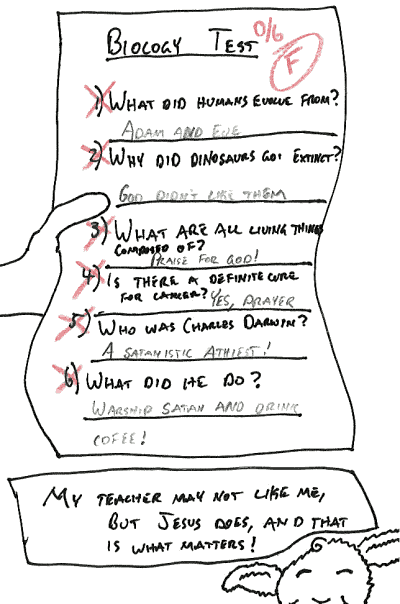
Go to church or die! Drop that coffee demon!
By 17 year old Chrono: Present douchebag.
If you are asian, gay, jewish, or like ragae, you're going to hell.
by anonymous, Future unemployable IT professional.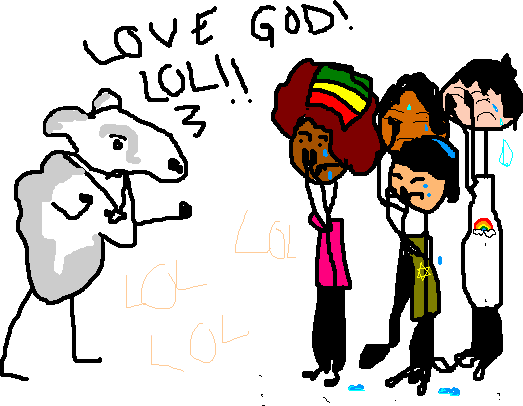
This kid thinks that the shimp guy from Futurama is real ... as real in fact as unicorns and africa.
by Carolyn, 15: Future unsatisfied wife of 50 years to a man she hates.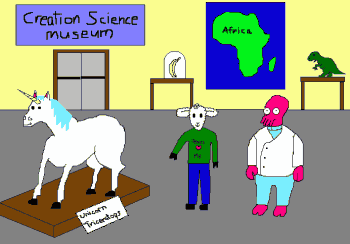
Holy shit. Kill them all jesus! Nuke the fuckers.
by Katie, age unknown: Future live-in-fear-of-anyone-ever-ever-finding-out lesbian.
I'm not sure what this kid's point is. I do know that he and his parents are idiots.
By Sean: Future GUY WHO ALWAYS TYPES IN ALL CAPS BECAUSE IT MAKES HIM RIGHT BECAUSE HE MEMORIZED THE TERM 'POLYSTRATE TREES' TO USE OVER AND OVER AND OVER WITHOUT ANY KNOWLEDGE OF GEOLOGY TO APPEAR SMART AS THE RESIDENT 'CREATION SCIENCE EXPERT' ON THE WWW.3000YEAR-OLD-EARTH.COM FORUM, FOR WHICH HE WILL BE THE SOLE MODERATOR AND ONE OF 9 USERS, EVER.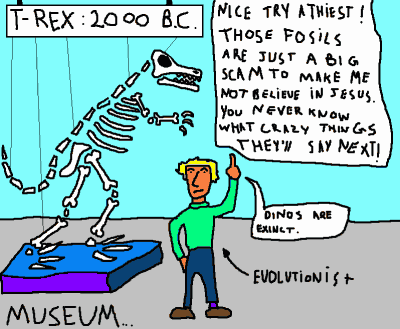
This picture sucks. T-rex had two fingers douchebag!
By Jimmy, future drug addict
Coffee: satan's choice
By Alice: future chronic trivial pursuit loser
OMG!!! AN ATHEIST ON THE LOOSE! CALL THE COPS!SHOOT HIM SHOOOT HIM!!!!
by Jenny, age 9: Future attendee of the G.W. Bush Memorial Library and it's 7 or 8 books.
What a confusing method. I thought they were AGAINST hallucinogenic drugs and homosexuality? Whatever.
Keith, age 9: Future hated father.
Kill! Kill! Kill!
By Judy, age unknown: Future fundamentalist nutjob.
If you love Jesus, you get to grow a full beard by age 7.
By Richard, age unknown: Future guy who can't seem to get his shit together after learning at age 16 his life has been a lie and you can trust nobody.
For more totally awesome, hate filled and ignorant bullshit, go to their stupid website.
Thursday, August 23, 2007
Holy shit I made a blog that someone might read someday, but I doubt it.
http://bryanherp.blogspot.com
It's about all the snakes and other shit I find when I'm out avoiding all the douchebags I have to tolerate in life. By 'douchebag' I mean anyone that's ever at a gas station or on a road at any time. People at work are exempt because I hide in my office all day and never see anyone.
Secondly look at how awesomely I fucked up pasting the DIGG.COM button into my blog. I don't really suck that bad at HTML or thinking in general, I just fail to give a horsefuck about it.
Labels: Field Herpetology, Hiking, Nature, The Internet
Wednesday, August 22, 2007
Potomac Accord
"
we come into a town we don't know, or maybe one where we have seen the area around the venue before... some awkward bands show up who sometimes look at the ground, or sometimes want to know what the best rock venue in your town is to play so they can set up their event there. we watch maybe a handful of small nervous and innocent people show up, but neither of us really talk to each other and we carry our weighted equipment past them and are sometimes brushed by the often disinterested and desensitized sound-man or door-man who quotes us the process of calling the night complete, but isn't interested in a conversation or sharing experiences and stories... you really cannot blame them though, they've submitted themselves to the company of total strangers nightly who are gone more quickly than they arrived, but we try our best.
we carry our stuff in, often in a rush to set it up and set back to a cold drink and rest on a wooden chair with hope that maybe someone will show up...
↑ less ↑we toss our experiences out into the public every single night possible with hope that someone may understand the message... we play to a room more often filled with smoke and clatter than conscious people, people who go home and forget the names of the bands, forget the instruments that composed the sounds, forget how far they may have come, and sometimes even forget the evening entirely... but they may have had a good time. you then carry your weighted equipment out the door, maybe down some narrow, dark, aging steps. sometimes all of this in the freezing rain when you have forgotten your jacket, or the soaking rain and the van smells like mildew, rust, and aluminum... cramming your wet bodies and your wet guitars into it...
but then there is one person who comes up and tells you something you will never forget for the rest of your life, and you realize that you have seen and experienced something completely unique to that particular evening, and it is beautiful. you realize that you have crafted something ambitious, personal, evocative, and to your personal life even maybe revolutionary.
in that moment the rain flows like stanzas from an aged poem handed to you on a piece of paper from someone you just met in a town, on a street, you had never known...
The Potomac Accord, St. Louis MO"
A very good CD, I must say.Labels: Digital Music, Music, reviews
Thursday, August 2, 2007
Wednesday, August 1, 2007
GamePolitics.com » Blog Archive » African Women’s Blog Critical of Resident Evil 5 Trailer
GamePolitics.com » Blog Archive » African Women’s Blog Critical of Resident Evil 5 Trailer
Retarded. Zombies can only be white, even in Africa, or else you're a racist.
Wednesday, July 18, 2007
Top 10 reasons that the internet is retarded
I am on the internet all day, nearly every day. It's ridiculous. All day I click on shit that I don't care about, like "Top 7 shitty movies of 1996" and "9 Worst action figure accessories". Time to make my own list.
The Top 10 Reasons that the internet is complete bullshit.
Reason 1: myspace.com
Reason 2: One of those titles I click on but don't read after I do. Golf.
Reason 3: i never capitalize letters anymore or use proper punctuation .,...... and nobody else i know does either
Reason 4: I'm an accomplished artist and designer, yet my blog looks like horseshit, and I don't care.
Reason 5: this is boring. i quit.
Here's a starwars toy I found in a creek over the weekend. Look at my wet pants.
Labels: technology, The Internet
Sunday, July 15, 2007
Thursday, July 12, 2007
Waterrrrrrrrrrrrrrr
ESA Portal - Water, water everywhere - on an extrasolar planet
Water, water everywhere - on an extrasolar planet
Scientists report the first conclusive discovery of the presence of water vapour in the atmosphere of a planet beyond our Solar System.
The discovery was made by analysing the transit of the gas giant HD 189733b across its star in the infrared.
Giovanna Tinetti, ESA fellow at the Institute d’Astrophysique de Paris, and colleagues from around the world, used data from NASA’s Spitzer Space Telescope. They targeted planet HD 189733b, 63 light-years away, in the constellation Vulpecula.
The planet was discovered in 2005 as it dimmed the light of its parent star by some three percent when transiting in front of it. Using Spitzer, Tinetti and the team observed the star, which is slightly fainter than the Sun. They watched its starlight dim at two infrared bands (3.6 and 5.8 micrometres).
Had the planet been a rocky body devoid of atmosphere, both these bands and a third one (8 micrometres), recently measured by a team at Harvard, would have shown the same behaviour.
Instead, as the planet’s tenuous outer atmosphere slipped across the face of the star, the starlight absorbed showed a different, distinctive pattern. The atmosphere absorbed less infrared radiation at 3.6 micrometres than at the other two wavelengths.
“Water is the only molecule that can explain that behaviour,” says Tinetti.
The presence of water vapour does not necessarily make it a good candidate in the search for planets that harbour life. “This is a far from habitable world,” she adds.
Instead of a rocky world like Earth, HD 189733b is large, about 1.15 times the mass of Jupiter. Located just 4.5 million km from its star, it orbits it in 2.2 days. In comparison, Earth is 150 million km from the Sun; even Mercury, the innermost planet, is 70 million km away.
| |||
Transiting exoplanet HD 189733b, in the infrared |
HD 189733b’s atmospheric temperature is about 1000 Kelvin (a little more than 700°C) or higher, implying that the significant amounts of water vapour in the atmosphere cannot condense to fall as rain or form clouds. The temperature would have to be about five times lower to form clouds of water vapour or rain.
That does not mean the atmosphere is sedate, however. The planet is gripped so tightly by the gravity of its star that one hemisphere constantly faces the star, heating the planet only on one side. This probably generates fierce winds sweeping from the day-side to the night-side. “There are a thousand things to learn about these planets,” says Tinetti.
Although, being a gas giant, the planet is an unlikely candidate in the search for life, these results increase hopes for the detection of water on other rocky planets, which astronomers hope to discover in the near future.
France‘s COROT mission, in which ESA participates, is expected to detect dozens of transiting gas giants, and has been working so well that it may also detect nearly Earth-sized worlds.
Atmospheres of rocky planets should be much more tenuous, so they will have to wait for future space telescopes, such as the James Webb Space Telescope, before they can be investigated.
Further into the future, the mission Darwin is expected to be proposed to ESA in the context of the Cosmic Vision Programme, its launch proposed sometime after 2018. A constellation of four spacecraft, Darwin’s goal would be to find and analyse atmospheres of Earth-sized planets, looking for telltale signs of water vapour and other gases that might betray life on those worlds.
Notes for editors:
The findings appear in the 12 July 2007 issue of the scientific journal Nature. The original paper, titled ‘Water vapour in the atmosphere of a transiting extrasolar planet’, is by G.Tinetti, A.Vidal-Madjar, M-C. Liang, J-P. Beaulieu, Y. L. Yung, S. Carey, R. Barber, J. Tennyson, I. Ribas, N. Allard, G. Ballester, D.K. Sing, F. Selsis.
NASA's Jet Propulsion Laboratory (JPL), Pasadena, California, manages the Spitzer Space Telescope for NASA's Science Mission Directorate, Washington. Science operations are conducted at the Spitzer Science Center at the California Institute of Technology (Caltech), also in Pasadena. Caltech manages JPL for NASA.
For more information:
Giovanna Tinetti, fomer ESA fellow at Institute d’Astrophysique de Paris, France; currently at University College London, UK
Email: Giovanna @ apl.ucl.ac.uk
Jean-Philippe Beaulieu, Institute d’Astrophysique de Paris, France
Email: Beaulieu @ iap.fr
Jonathan Tennyson, University College London, UK
Email: J.Tennyson @ ucl.ac.uk
Fabio Favata, ESA Coordinator for Astronomy and Fundamental Physics missions
Email: Fabio.Favata @ esa.int

